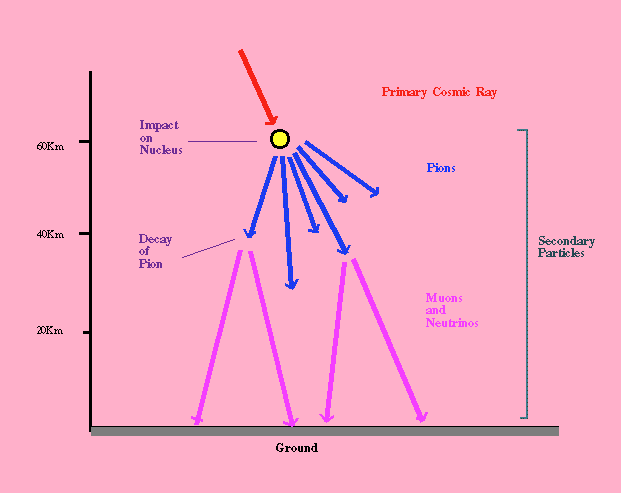
There are two types of cosmic rays which exist. Primary and Secondary. Primary cosmic rays are the names given to cosmic rays when they are initially formed (Click here to find out where cosmic rays come from). However primary cosmic rays are very rarely detected at ground level because they generally undergo collisions with atoms very high up in the atmosphere. These collisions produce a cascade of secondary cosmic rays which shower down through the atmosphere to the earth's surface. It is of this type of cosmic ray which the spark chamber detects.
The diagram below shows the primary cosmic ray colliding with the nucleus at about 60Km above ground level, where the collision produces a cascade of secondary particles, known as a cosmic-ray shower.

Figure 1: A cosmic Ray Shower
It can be seen that the secondary cosmic rays include pions (which decay to muons, neutrinos and gamma rays) as well as positrons and electrons produced by muon decay and gamma ray interactions with atmospheric atoms.
So why can primary cosmic rays decay to produce these secondary cosmic rays?
Primary cosmic rays, as discussed above have high energy, E. By the usage of Einstein's well known equation:
E = mc2
It can be seen that the energy of the primary cosmic ray can be converted into new mass, i.e. new particles can be produced from the energy of the primary cosmic ray. These new particles are the secondary cosmic rays. After a while, and if enough energy is available to individual secondary particles, these can decay to produce yet more secondary particles.
It can therefore be appreciated that 1 primary cosmic ray can cause the production of many secondary cosmic rays which is what the spark chamber detects. The nearer one gets to ground level, the secondary particles become less and less energetic. So the energy of most secondary cosmic rays detected at ground level is a lot less then the energy of the original primary cosmic ray.
Although the spark chamber will detect all secondary cosmic rays, it is mainly muons which it detects in practice. This is because muons are very penetrating because they only interact electromagnetically. They also have a long life-time (2.2ms!) and there are thus lots of them around at ground level where the spark chamber detects.
Cosmic rays act in a similar way to particle beams in accelerators, in that they are a laboratory for producing new particles from. Indeed particles such as the Kaon, Pion, Muon and positron were originally discovered by studying cosmic rays.
Where do primary cosmic rays originate?
Return to home page